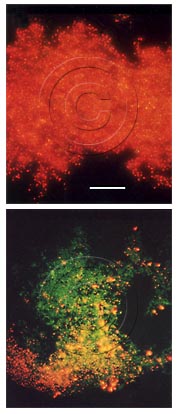Biofilm strategies: Meeting antimicrobial challenges
| The graph at right, shows how planktonic and biofilm cells of Pseudomonas aeruginosa respond differently to exposure to chlorine. One difference that is immediately obvious
from this graph is that killing rates of cells in the biofilm are always lower than
those for planktonic bacteria. A second difference is that increasing the concentration
of chlorine does more to improve the killing rate against biofilm bacteria than it
does for planktonic cells.
Practical ImplicationsCBE antimicrobial research has been motivated by the nearly universal observation that microorganisms growing in biofilms are less susceptible to all types of antimicrobial agents than the same microorganisms when grown in conventional suspension cultures. The practical suggestion that follows from this work is that biofilms in industrial settings are most effectively treated with a relatively high concentration of antimicrobial. A concentrated dose, even if brief, will tend to be more effective than a prolonged treatment of lower concentration. The solution in medical biofilms is not so simple, however, since the dose of antibiotic required to kill biofilm bacteria may be high enough to kill the patient! Why are biofilm cells less susceptible to killing? (See Section 4)
Next section: Gradients and niches |
 |
|
 |
Epifluorescence micrographs of frozen sections of a mixed biofilm (K. pneumoniae and P. aeruginosa) grown on stainless steel and treated with 2 mg monochloramine (a disinfectant) per liter. Before treatment (top) the biofilm is thick; the red stain indicates metabolically active cells. After 2 hours of treatment (bottom) much of the biofilm stains green (dead), but cell activity is still present at the bottom of the biofilm.
|
|

